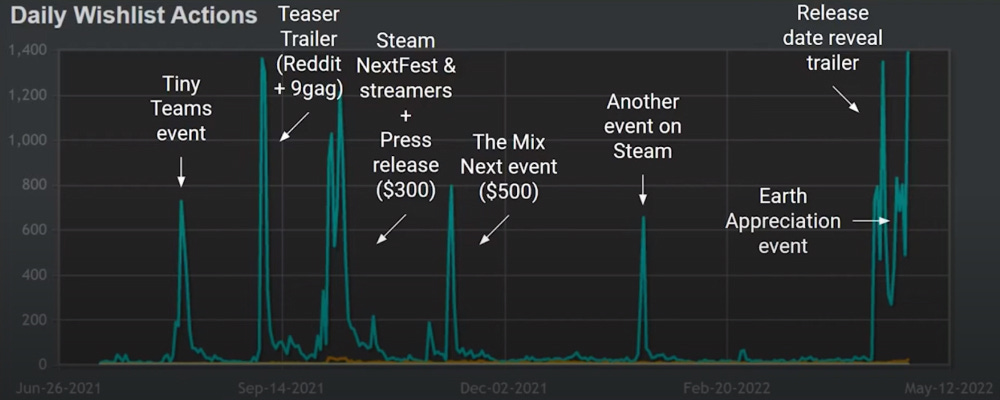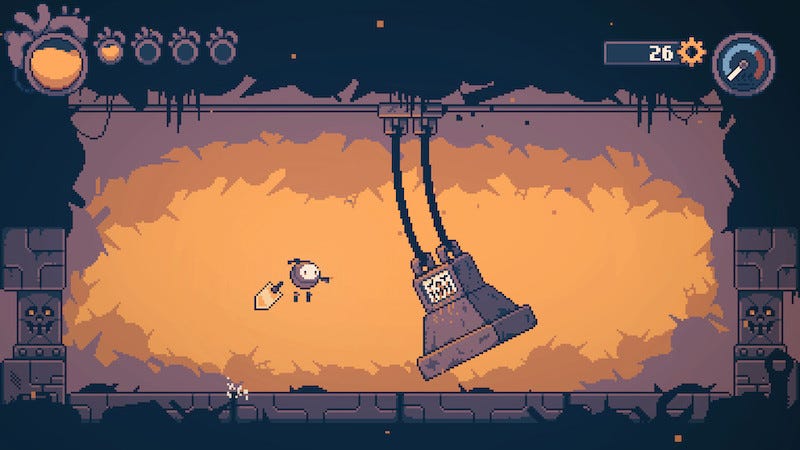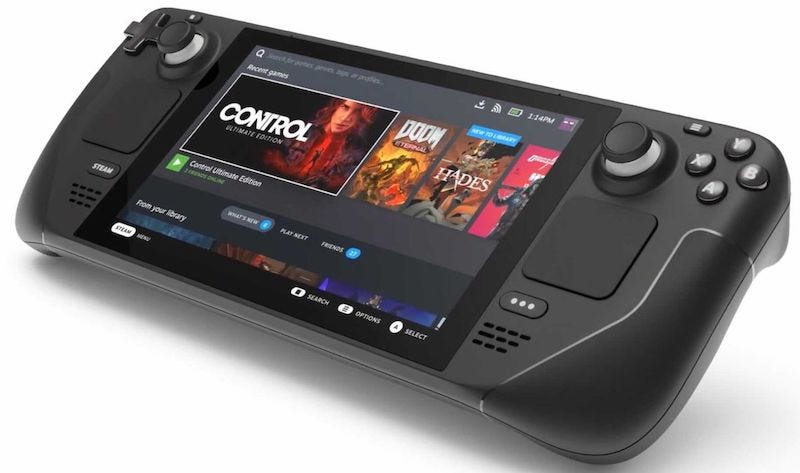How to make a hit indie Metroidvania: the lowdown!
Publikováno: 5.7.2022
Or at least, this is how Haiku The Robot did it.
[The GameDiscoverCo game discovery newsletter is written by ‘how people find your game’ expert & company founder Simon Carless, and is a regular look at how people discover and buy video games in the 2020s.]
Hey folks - we’re back, and it’s apparently Tuesday July 5th. (Sorry we forgot to tell you that we were off Monday for that ‘getting rid of the British’ holiday that confuses me, as a Brit marooned in America. :P)
Anyhow, newsletters are going out Tuesday, Thursday and Friday this week (U.S. West Coast time). Oh, and less than a week left for our 25% off Plus deal, for anyone not hooked up with all that extra data, eBooks, Discord, exclusive Friday newsletter, etc.
Making a hit Metroidvania: lessons from Haiku?
When talking to clients, we often mention that the Metroidvania genre can be a good one, especially for small teams. Competition is fierce. But we think players who like the subgenre are happy to buy and try multiple contrasting games in it, yearly.
So we dug the success of Haiku The Robot from solo dev Jordan Morris, which launched on April 28th. According to our GameDiscoverCo Plus data, it was the 29th most popular new Steam game for April, ranked by ‘# of reviews in Week 1’, and is 22nd if ranking by ‘lifetime reviews’. (It also converted ‘Hype’ at 3x what we predicted!)
We spotted a YouTube version of Jordan’s talk at a recent GameDev Estonia organized event, and reached out to him for extra context. Overall, the game launched with 37,000 Steam wishlists and sold around 15,000 copies in the first six weeks. For a solo indie, that’s great. (50-100k lifetime units sold should be doable!)
So what are some of the top things that Jordan did right? We reckon it’s the following:
Built up initial community via a Kickstarter: We can be a little mixed on whether to crowdfund, due to amount of updates and maintenance - and sometimes rewards - you have to give backers. But Jordan’s UKP 30,000 Kickstarter clearly helped orientate him correctly & boosted initial fan interest.
Find your niche and develop community around it: Jordan explained: “Hollow Knight is one of the most popular Metroidvanias of recent times so I decided to spend like a lot of effort to [reach] that community”, including both fans and streamers.
Be incredibly active & responsive to your fanbase: he noted in the talk:“Your community is fantastic, especially early on… you can send early builds out to fans and they’ll give you feedback and ideas. It also helped me with motivation a lot because if you are working alone, it's almost like a support group that's like keeping you afloat.”
Plan your launch around a marketing ‘high’: this one’s clever -“I tried to plan my launch day around a Steam event called “Going Rogue”, which was specifically targeted towards roguelites and roguelikes, Metroidvanias and Souls-likes.” Smart idea to launch Haiku just before its inclusion in that.
Look - with these success stories, there’s a danger that you just list the things that everyone (who is smart!) ends up doing. So it can dangerously devolve to: ‘right game & right subgenre & right market/execution = success… if you are lucky!’
But on a higher level, it’s about ‘hook’, and executing on the promise you show in that hook. And I actually asked Jordan - who is a regular GameDiscoverCo newsletter reader - directly what he thought the game’s hook was.
His self-evaluation of Haiku The Robot’s strong points seemed quite self-aware - though intriguingly visual focused - and we’re reprinting in full. Here’s what he said:
“The game has a strong visual art style. Almost Game Boy-esque. The simple colored backgrounds provide a good contrast between the player and foreground elements which focuses peoples attention on the most important parts of the game. You know immediately what to look at (and this also helps with gameplay).
The different color palettes stands out as well. The warm orange palette especially draws people in and a lot of the people instantly remember my game when they see this orange color in a screenshot/GIF. The colors also compliment the cute yet creepy aesthetic of the game.
Lastly, the game doesn’t deviate from the standard Metroidvania formula and uses well-known mechanics/tropes - people can easily relate it to other games that they’ve played. And since it’s my first game, I thought it was more important to focus on getting the basics absolutely right, rather than making something new that people haven’t seen before. Plus, the general concept of a post-apocalyptic world inhabited by machines is something that most people can easily understand and visualize.”
So though Jordan’s conclusion was that “familiarity, nostalgia, and visual clarity helped sell the game” - which we agree with. I’d also add that the game has quite a lot of implied depth through its map and item screens.
And Haiku is just really well executed as a game. It has 93% Positive reviews, our of its 771 total. (The only negative reviews come from it maybe being a bit too close to Hollow Knight, gameplay and unlock-wise.)
As a bonus, the Games Estonia talk includes slides with annotated Steam wishlist graphs (we love those!), so we’ll reprint those to end. First, here’s early wishlist spikes:
Secondly, here’s the wishlists in the 9 months or so before release, annotated:

And finally, we get to see the wishlists immediately before and after Haiku The Robot’s release, which is a useful view, too:
How much should you worry about Steam Deck?
Valve’s smart ‘uses Linux to emulate PC games’ handheld the Steam Deck is very much on the mind of many folks - not least because there’s now 1,800 Steam Deck Verified titles.
So we’ve fielded a couple of questions recently. What if you were Deck evaluated and came back Unsupported, or haven’t been evaluated at all? Is this a big sales problem for your game that you should scramble to fix? We say no, for these reasons:
As Ars Technica has just done, you can use Steam’s hardware report and a Steam MAU estimate to estimate the number of Steam Decks ‘in the wild’, and it’s still marginal: “We can extrapolate that roughly 77,000 Steam Deck systems were in the wild when Valve's process automatically gathered data in the final week of May.” There’s just not that many devices out there - yet.
Since players get access to their entire Steam catalog on Deck, you just don’t get the ‘early adopters have to buy your game’ boost that we often saw on new consoles like Nintendo Switch. Many people are experimentally trying their existing catalog - much of which ‘just works’. Not many are buying games expressly to play on Deck - yet.
Overall, here’s the skinny: for popular games, getting your Steam Deck compatibility right swiftly is important. You want to be responsive. But for smaller new titles, being Steam Deck supported doesn’t look like a sales driver to us. It’s a ‘nice to have’ that you should get around to. But prioritize selling your game to regular PC players first.
Long-term, the amount of Steam Decks in customer hands may increase quite swiftly. Brad Lynch just noted that June’s Steam hardware survey now has 7.57% of Linux users using the Steam Deck custom CPU, up from 5.2%. This implies that there are now >100k Decks out there.
And with Valve noting that shipments will ‘more than double’, the company could be shipping 20k Decks per week, instead of the nearly 10k a week they did in June. So perhaps we’ll get to 1 million Decks shipped by early next year, depending on supply chain issues?
[One intriguing addendum: there’s at least one Chinese-made portable PC running Steam Deck’s OS, and Valve has already said that the Deck OS is available for free “for any manufacturer that wants to make a similar product”. After the supply chain horridness loosens up, could we see a bunch of Steam Deck ‘clones’ from third parties?]
The game discovery news round-up..
Well, that was a lot of info. So let’s poke around the game discovery and platform news to give you a bunch more data to end out the newsletter, shall we? Here we go:
We don’t talk about Steam China (as opposed to ‘Steam Global players in China’) that much, but Perfect World has a Steam China showcase on July 14th, and “more than 40 global game companies including Gamera Games, Cube Game, bilibili Game and other great game partners will participate in this online showcase, with over 80 recommendable titles.”
Didn’t realize that Samsung has launched a whole ‘gaming TV hub’ for its 2022 smart TVs, with “quick access to Nvidia’s GeForce Now, Google Stadia, Utomik, Twitch, and Microsoft’s new Xbox TV app. Even Amazon Luna will be available soon.” There’s a snazzy Samsung x Xbox ad further hyping the trend, and “using your favorite controller” is an interesting detail too. Heck, the Xbox page for it even says ‘Sony PlayStation controllers’, showing hardware agnostics to the max.
Apple now lets developers in South Korea bypass in-App Store payments, after a new law passed. But in addition to lots of other negatives: “Apple detailed how, like Google, it still intends to charge a high commission - in this case, 26% - for transactions outside its payment system.” If you want to get deeper, FOSS Patents has a more complex blog on the larger ramifications of these ‘bad faith’ implementations of alternative payment structures.
Over at VGInsights, they’ve analyzed the 6,000 games released on Steam in the first half of 2022. And there’s some interesting tidbits, of course: “Out of the 6,015 games, 75% were priced under $10. Only 56 of the games released in 2022 were priced above $40…. 80% of the games released have made less than $5,000 in gross revenue in their lifetime.”
Shout-out to The Verge for doing a great series on ‘how creators get paid online’, including some profiles of Unity Asset Store creators and companies making branded worlds for Fortnite, all relevant to our platform focus. (Bonus: a chat with indie Playdate game creators.)
The crew at Game Conference Guide released its 2022 survey results. And with COVID still with us, the cognitive dissonance is palpable: “74%… picked networking as a number one reason to attend an event in 2022… [but] social distancing and other precautions related to the… pandemic are still the number one concern. 60%… of all respondents see this as a #1 reason to not attend in-person events.”
A little more regional lootbox shenanigans: The Netherlands “could be the next country to ban loot boxes in video games, as multiple political parties unite behind the bill which would see the country outlaw randomised in-game purchases”, and Spain “is set to become the first European country to have a law regulating the use of so-called loot boxes in videogames.” The ball, it is rolling downhill…
Microsoft’s president Brad Smith is all in on the anti-App Store bandwagon: “When it comes to app store fairness, we would like to see some changes. I do think that a disproportionately and even surprisingly high percentage of the profits in gaming are going not to people who create games, not to people who create consoles, not to people who are really providing gaming services, but rather to the mobile platforms and app stores.” Spot the careful carveout for Xbox hardware (“create consoles”) here.
Microlinks: Nintendo has launched a subscription service for Switch repairs in Japan; Niantic's Campfire social app - which will be integrated into all of its AR games, including Pokemon Go - will soon begin global rollout; Xbox 360 games will no longer be part of Xbox Games with Gold in October.
Finally, just a shout-out that the next Steam NextFest is taking place on October 3rd-10th, according to the new sale page set up for it on Steam’s website. So perhaps something to put in your calendar, if you haven’t already? Toodle-oo!
[We’re GameDiscoverCo, an agency based around one simple issue: how do players find, buy and enjoy your premium PC or console game? We run the newsletter you’re reading, and provide consulting services for publishers, funds, and other smart game industry folks.]



